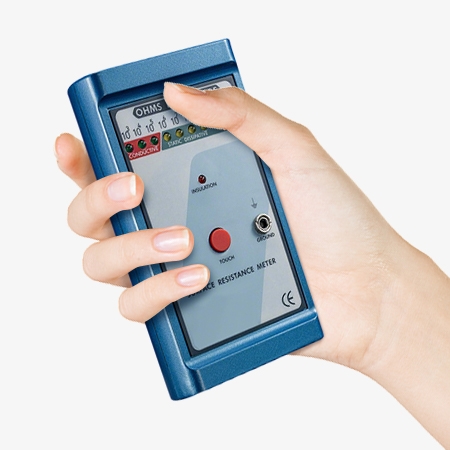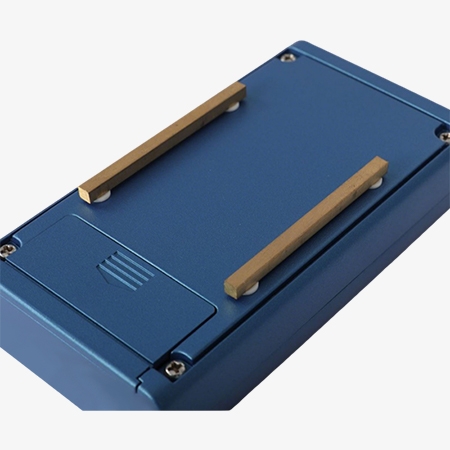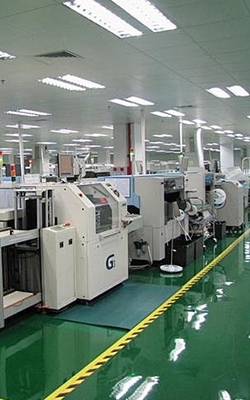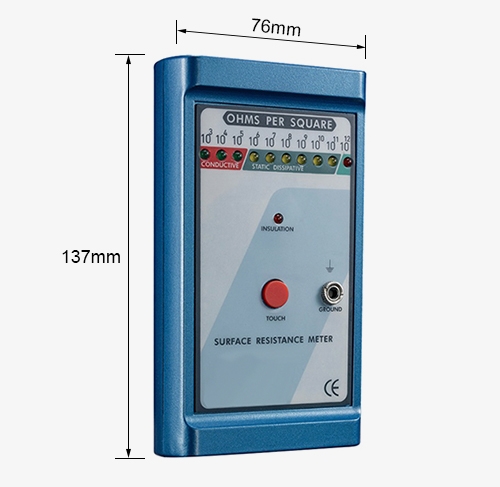A surface resistance meter is a specialized instrument used to measure the electrical resistance on the surface of materials, especially those designed for electrostatic discharge (ESD) protection. By monitoring surface resistance, it helps prevent static buildup, protecting sensitive electronic components from electrostatic damage.

Small and Handheld Surface Resistance Meter
- Ease of Use and Convenience. The compact design makes the instrument simple to handle and operate. A portable ESD surface resistivity meter can be carried in one hand or placed in a pocket, allowing technicians to perform quick checks without the need for bulky equipment.
- Space-Saving Design. In modern work areas, space is often limited. A small resistance meter takes up very little storage room. It can be conveniently stored in toolboxes, drawers, or bags without adding clutter.

Equipped Copper Strip Electrodes
- Testing the Electrical conductivity of an Object. Press the "TOUCH" button, surface ESD tester can measure the resistance value on the object surface by putting two parallel copper strip electrodes close to the object surface. Testing the surface conductivity, surface electrostatic dissipation performance, and surface insulation. The LED light corresponding to the value will illuminate.
- High Accuracy and Stability. Copper has excellent electrical conductivity. And the stable performance of copper electrodes helps maintain reliable results across repeated tests.
Applications
SISCO's surface resistance meter is an essential tool for measuring the electrical resistance of surfaces and materials, particularly in environments where static electricity control is critical. Its primary applications are in electronics manufacturing, cleanrooms, and laboratories. Surface resistivity meter ensures that both equipment and materials meet safety requirements, preventing static-related hazards and ensuring reliable product performance.

ESD Workshop

Laboratory

Data Center

Electronic Industry
| Model | SISCO-SRT-1500A |
| Resistance Range | 103~1012 Ω |
| Working Voltage | 9V DC |
| Accuracy | ±1/2 decade |
| Dimension | 137*76*30mm |
| Gross Weight | About 500g |
Dimension:

Q1: What is a surface resistance meter?
A1: A surface resistance meter is an electronic instrument used to measure the electrical resistance of a material’s surface, typically expressed in ohms (Ω).
Q2: How to maintain a surface resistance tester?
A2: Maintaining a surface resistance tester ensures accurate measurements and extends its lifespan. Always store the meter in a dry, dust-free environment to prevent moisture or dirt. Regularly check and clean the electrodes using a soft, lint-free cloth. Avoid dropping or subjecting it to strong vibrations. Handle with care and avoid exposing it to extreme temperatures or corrosive substances.
Q3: Is the surface resistance meter suitable for cleanroom environments?
A3: Yes, a surface resistivity meter can be suitable for cleanroom environments. Portable, handheld meters allow operators to measure the resistivity of ESD mats, flooring, and work surfaces without disturbing the cleanroom conditions.
Tips: What kind of electrodes does ESD surface resistance meter use?
An ESD surface tester typically uses parallel bar electrodes, also known as copper strip electrodes, to measure surface resistance and resistivity of materials. The copper bars make firm contact with the test surface, allowing current to flow and resistance to be measured.
Thank you for buying industrial test and measurement equipment on SISCO.com, all products sold by SISCO and the partner cover a 12 months warranty, effective from the date of receiving the products.
What is covered?
SISCO is responsible for providing free spare parts, and free technical support to assist the customer to repair the defective products until the problem is solved.
What is not covered?
- Product purchased from anyone other than a SISCO store or a SISCO authorized reseller.
- Expendable parts.
- Routine cleaning or normal cosmetic and mechanical wear.
- Damage from misuse, abuse or neglect.
- Damage from use of parts other than SISCO approved.
- Damage from use outside the product’s usage or storage parameters.
- Damage from use of parts not sold by SISCO.
- Damage from modification or incorporation into other products.
- Damage from repair or replacement of warranted parts by a service provider other than a SISCO authorized service provider.
- Damage caused by the application environment not meeting the product usage requirements and the failure to perform preventive maintenance.

